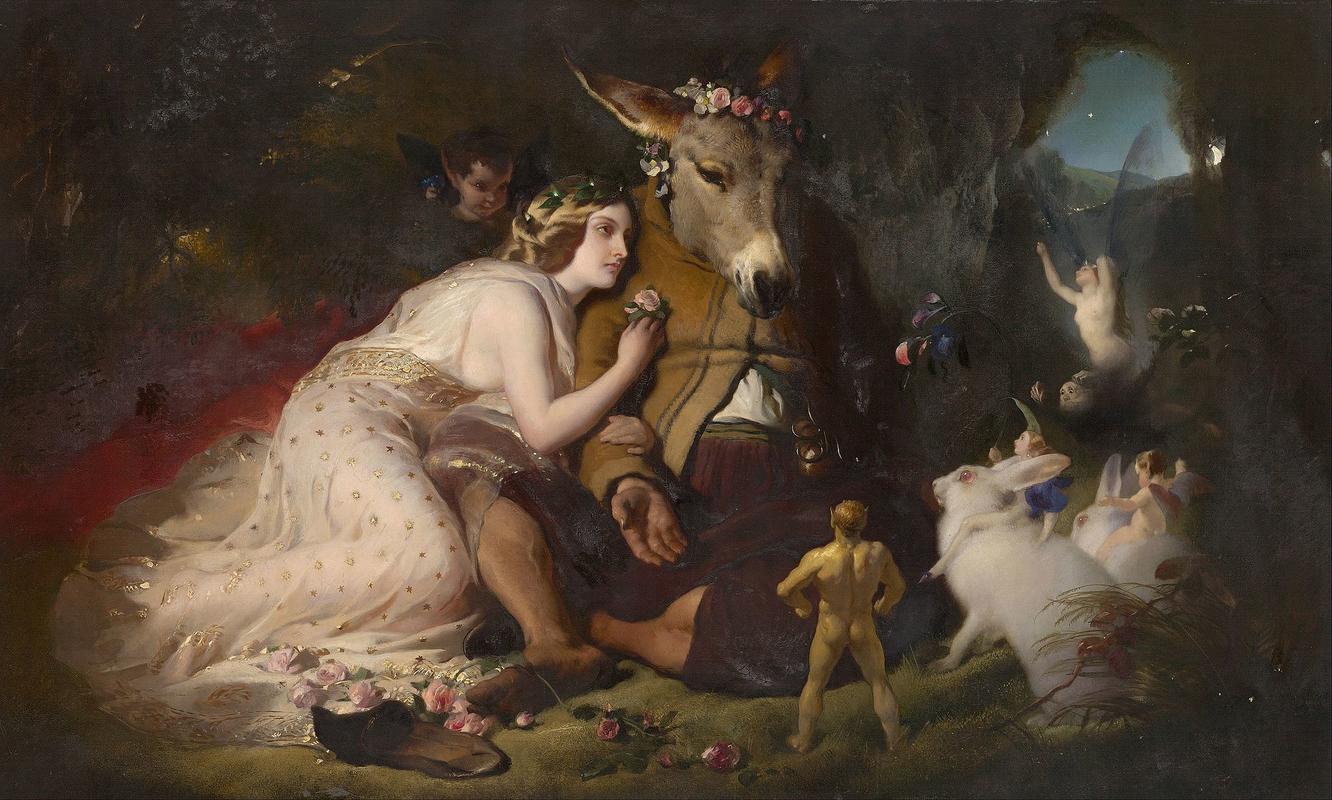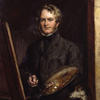More about Scene from A Midsummer Night's Dream. Titania and Bottom

Contributor
It may not look it, but this is actually the most British picture of all time.
See it all starts with Edwin Landseer, obviously a British man himself. He was a lover of fancy dogs and one of Britain's first animal right’s activists. Like many famous artists he was a very well connected individual, however, very rarely do an artist’s connections so entirely encompass their era. Landseer was friends with not only Charles Dickens and William Thackeray (the writer of "Vanity Fair") but also Queen Victoria. He was her favorite painter, and at one point she even called him “very good looking although rather short.” High praise indeed.
Obviously however, it doesn’t stop there, this picture is of Shakespeare's "A Midsummer Night’s Dream." The play is supposed to take place in Greece, however the part of the story depicted is solidly dominated by British folklore and diction. In this scene Titania, Queen of the Fairies, is under the spell of a love potion and has fallen head over heels for a character called Bottom. So here we have a fairy queen, a very British idea, and the name Bottom, a very British word that has barely changed from its old english root of “botm.”
Finally, there is who the painting was commissioned for. Isambard Kingdom Brunel was a major player in the industrial revolution. He was responsible for the creation of quite a few railroads and docks for steam boats. Additionally, he was a contributor to the Thames Tunnel. How does this man of industry happen to bump elbows with an artist who liked to chill with the very anti-industrial Charles Dickens you might ask? Well the answer is that they were both knights.
So in summary: an artist who was a favorite of one of the greatest British queens, and was also friends with one of the greatest British novelists, did a painting of a play by the greatest British playwright, for a man who helped shaped the greatest period in British history.
Sadly for Britain, this painting is currently located in Australia.
Sources
- Delafenêtre, David “Landseer’s Ethics: The Campaign to End “Cosmetic Surgery” on Dogs in Australasia” Simon Fraser University 08/06/2009 https://link.springer.com/chapter/10.1007/978-90-481-2479-4_11
- “Edwin Henry Landseer” artuk.org viewed on 08/22/2019 https://artuk.org/discover/artists/landseer-edwin-henry-18021873
- “Isambard Kingdom Brunel” The Genealogist 10/20/2011 https://www.thegenealogist.co.uk/featuredarticles/2011/isambard-kingdom…
- Online Etymology Dictionary “Bottom” Douglas Harper 2019 https://www.etymonline.com/word/bottom
Featured Content
Here is what Wikipedia says about Scene from A Midsummer Night's Dream

Scene from A Midsummer Night's Dream. Titania and Bottom is an 1851 oil-on-canvas painting by British artist Edwin Landseer. Landseer was mainly known for his paintings of animals: this is his only painting of a fairy scene. The painting depicts a scene from the third act of William Shakespeare's play A Midsummer Night's Dream. It has been in the collection of the National Gallery of Victoria in Melbourne, Australia since 1932.
The painting shows Titania, Queen of the Fairies, after she has been given a love potion, embracing the temporary object of her love, the mechanical Nick Bottom. Bottom has been also enchanted and has the head of an ass. They are observed by other fairy folk, and the scene is decorated with flowers and rabbits.
The work measures 82.0 × 133.0 centimetres (32.3 × 52.4 in). It was one of several paintings of scenes from works by Shakespeare commissioned by Isambard Kingdom Brunel in 1847 to decorate the dining room of his house in London. Landseer was paid £450. Brunel left the choice of subject to the artists, and Landseer may have chosen this scene so he could include several animals. Other works were commissioned from Charles West Cope, Augustus Egg, Frederick Richard Lee, Charles Robert Leslie, and Clarkson Frederick Stanfield.
The painting was first exhibited the Royal Academy summer exhibition in 1851, and was immediately a popular success. It was praised by Queen Victoria in her diary, and by Lewis Carroll, who admired the white rabbit; the work may have influenced the white rabbit in his book Alice's Adventures in Wonderland.
After Brunel's death in 1859, the painting was sold at auction in April 1860 and acquired by Lord Robert Pelham-Clinton for £2,800. After the death of Pelham-Clinton, it was acquired by Adelbert Brownlow-Cust, 3rd Earl Brownlow, and later sold to Sir William Quilter, 1st Baronet. It was then sold to Henry Lowenfeld at Christie's in 1909 for £2,400 (the auction also included Holman Hunt's The Scapegoat). After Lowenfeld's death in 1931, his widow sold the painting to the National Gallery of Victoria, Melbourne (funded from the Felton Bequest) where it remains today.
Check out the full Wikipedia article about Scene from A Midsummer Night's Dream












